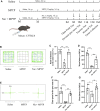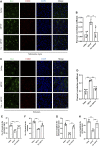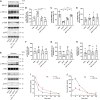Nicotine alleviates MPTP-induced nigrostriatal damage through modulation of JNK and ERK signaling pathways in the mice model of Parkinson's disease
- PMID: 36817162
- PMCID: PMC9932206
- DOI: 10.3389/fphar.2023.1088957
Nicotine alleviates MPTP-induced nigrostriatal damage through modulation of JNK and ERK signaling pathways in the mice model of Parkinson's disease
Abstract
Introduction: Nicotine (Nic) has previously been proven to reduce neurodegeneration in the models of Parkinson's disease (PD). The present study is intended to investigate the detailed mechanisms related to the potential neuroprotective effects of Nic in vivo. Methods: We established a PD model using 1-methyl-4-phenyl-1,2,3,6-tetrahydropyridine (MPTP)-induced C57BL6 mice (25 mg/kg/d, 5 d, i.p.) to investigate the neuropharmacological modulation of Nic pretreatment (2.5 mg/kg/d, 5 d, i.p., 30 min before MPTP injection) from the perspectives of neurobehavioral assessment, the pathological alterations, microglial cell inflammation and MAPK signaling pathways in specific brain regions. Results: The open field test, elevated plus maze, rotarod and traction test suggested that Nic pretreatment could significantly improve MPTP-induced motor impairment and had an anxiolytic effect. Nic was found to improve neuroapoptosis, enhance tyrosine hydroxylase activity, and reduce the accumulation of the phosphorylated α-synuclein in the substantia nigra and striatal regions of PD mice by TUNEL and immunohistochemical assays. Immuno-fluorescent method for labeling Iba1 and CD68 indicated that Nic remarkably alleviates the activation of microglia which represents the M1 polarization state in the mice brain under MPTP stimulation. No significant difference in the expression of p38/MAPK pathway was found in the nigrostriatal regions, while Nic could significantly inhibit the elevated p-JNK/JNK ratio and increase the declined p-ERK/ERK ratio in the substantia nigra of MPTP-exposed brains, which was further confirmed by the pretreatment of CYP2A5 inhibitor to decline the metabolic activity of Nic. Discussion: The molecular signaling mechanism by which Nic exerts its neuroprotective effects against PD may be achieved by regulating the JNK and ERK signaling pathways in the nigra-striatum related brain regions.
Keywords: MAPK pathway; Parkinson’s disease; neuroprotective effect; nicotine; nigrostriatal region.
Copyright © 2023 Ruan, Xie, Wang, Guo, Li, Fan, Ji, Gong, Xu, Mao and Xie.
Conflict of interest statement
Authors JX, RJ, and ZG were employed by China Tobacco Jiangsu Industrial Co., Ltd. The remaining authors declare that the research was conducted in the absence of any commercial or financial relationships that could be construed as a potential conflict of interest.
Figures






Similar articles
-
Neuroprotective Effects of the DPP4 Inhibitor Vildagliptin in In Vivo and In Vitro Models of Parkinson's Disease.Int J Mol Sci. 2022 Feb 21;23(4):2388. doi: 10.3390/ijms23042388. Int J Mol Sci. 2022. PMID: 35216503 Free PMC article.
-
Shikonin ameliorates oxidative stress and neuroinflammation via the Akt/ERK/JNK/NF-κB signalling pathways in a model of Parkinson's disease.Clin Exp Pharmacol Physiol. 2022 Nov;49(11):1221-1231. doi: 10.1111/1440-1681.13709. Epub 2022 Aug 21. Clin Exp Pharmacol Physiol. 2022. PMID: 36054693
-
Combining nitric oxide release with anti-inflammatory activity preserves nigrostriatal dopaminergic innervation and prevents motor impairment in a 1-methyl-4-phenyl-1,2,3,6-tetrahydropyridine model of Parkinson's disease.J Neuroinflammation. 2010 Nov 23;7:83. doi: 10.1186/1742-2094-7-83. J Neuroinflammation. 2010. PMID: 21092260 Free PMC article.
-
Deferoxamine-mediated up-regulation of HIF-1α prevents dopaminergic neuronal death via the activation of MAPK family proteins in MPTP-treated mice.Exp Neurol. 2016 Jun;280:13-23. doi: 10.1016/j.expneurol.2016.03.016. Epub 2016 Mar 18. Exp Neurol. 2016. PMID: 26996132
-
Dose-related biphasic effect of the Parkinson's disease neurotoxin MPTP, on the spread, accumulation, and toxicity of α-synuclein.Neurotoxicology. 2021 May;84:41-52. doi: 10.1016/j.neuro.2021.02.001. Epub 2021 Feb 4. Neurotoxicology. 2021. PMID: 33549656
Cited by
-
Brain distribution and metabolic profiling of 4-(methylnitrosamino)-1-(3-pyridyl)-1-butanone in rats investigated by UHPLC-HRMS/MS following peripheral administration.Anal Bioanal Chem. 2023 May;415(12):2317-2327. doi: 10.1007/s00216-023-04655-1. Epub 2023 Apr 1. Anal Bioanal Chem. 2023. PMID: 37004550
-
Drugs from poisonous plants: Ethnopharmacological relevance to modern perspectives.Toxicon X. 2025 Jan 28;25:100215. doi: 10.1016/j.toxcx.2025.100215. eCollection 2025 Mar. Toxicon X. 2025. PMID: 39990776 Free PMC article. Review.
-
Neuroprotective mechanism of salvianolic acid B against cerebral ischemia-reperfusion injury in mice through downregulation of TLR4, p-p38MAPK, p-JNK, NF-κB, and IL-1β.Immun Inflamm Dis. 2023 Oct;11(10):e1030. doi: 10.1002/iid3.1030. Immun Inflamm Dis. 2023. PMID: 37904689 Free PMC article.
-
[Effects of nicotine exposure on endogenous metabolites in mouse brain based on metabolomics and mass spectrometry imaging].Se Pu. 2025 Apr 8;43(4):363-371. doi: 10.3724/SP.J.1123.2024.10005. Se Pu. 2025. PMID: 40133202 Free PMC article. Chinese.
-
Significance of nicotine and nicotinic acetylcholine receptors in Parkinson's disease.Front Aging Neurosci. 2025 Mar 21;17:1535310. doi: 10.3389/fnagi.2025.1535310. eCollection 2025. Front Aging Neurosci. 2025. PMID: 40191787 Free PMC article. Review.
References
-
- Anderson J. P., Walker D. E., Goldstein J. M., de laat R., Banducci K., Caccavello R. J., et al. (2006). Phosphorylation of Ser-129 is the dominant pathological modification of alpha-synuclein in familial and sporadic Lewy body disease. J. Biol. Chem. 281 (40), 29739–29752. 10.1074/jbc.M600933200 - DOI - PubMed
LinkOut - more resources
Full Text Sources
Research Materials
Miscellaneous

